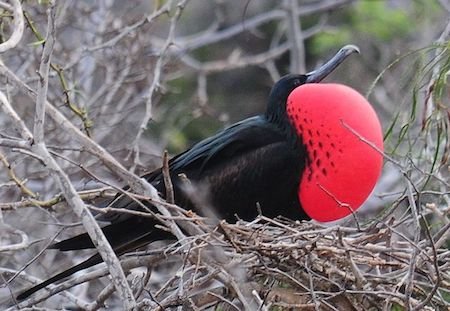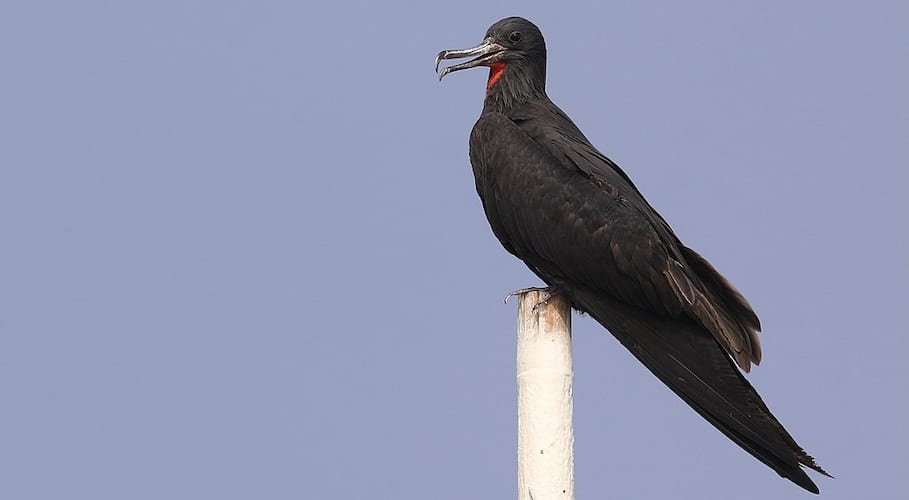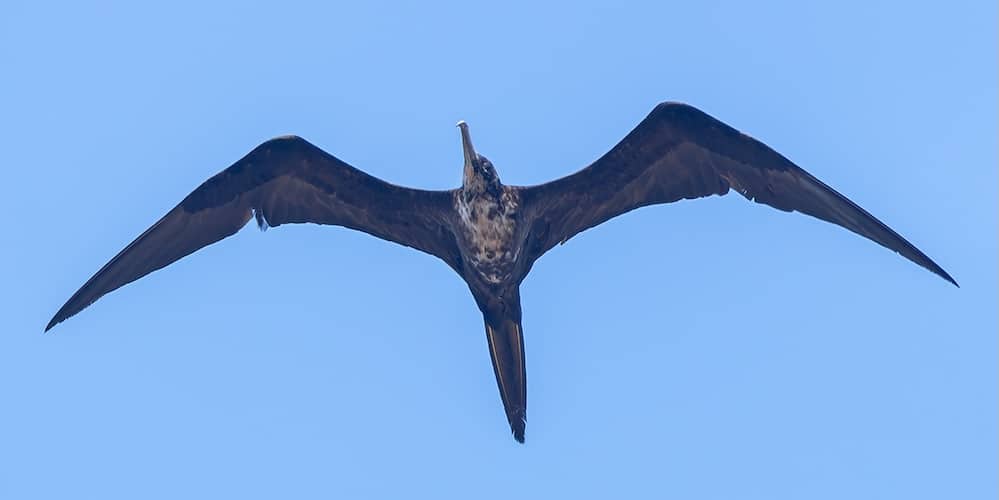Fregatidae – Frigatebirds

The Fregatidae or Frigatebirds are a family of seabirds, which are found across all tropical and subtropical oceans. They are Suliformes, along with Sulidae (Boobies & Gannets), Anhingidae (Darters) and Phalacrocoracidae (Cormorants & Shags). The five extant species are classified in a single genus, Fregata. All have predominantly black plumage, long, deeply forked tails and long hooked bills. Females have white underbellies and males have a distinctive red gular pouch, which they inflate during the breeding season to attract females. Their wings are long and pointed and can span up to 2.3 metres (7.5 ft), the largest wing area to body weight ratio of any bird.
Able to soar for weeks on wind currents, frigatebirds spend most of the day in flight hunting for food, and roost on trees or cliffs at night. Their main prey are fish and squid, caught when chased to the water surface by large predators such as tuna. They are referred to as kleptoparasites as they occasionally rob other seabirds for food, and are known to snatch seabird chicks from the nest. Seasonally monogamous, frigatebirds nest colonially. A rough nest is constructed in low trees or on the ground on remote islands. A single egg is laid each breeding season. The duration of parental care is among the longest of any bird species; frigatebirds are only able to breed every other year.

Lesser Frigatebird Fregata ariel – ©Shah Jahan CC BY-SA 4.0 via Wikimedia Commons
Three of the five extant species of frigatebirds are widespread; the Magnificent Frigatebird, Great Frigatebird and Lesser Frigatebird. Two are endangered the Christmas Island Frigatebird and Ascension Island Frigatebird, and restrict their breeding habitat to one small island each. The oldest fossils date to the early Eocene, around 50 million years ago.
Having the largest wing-area-to-body-weight ratio of any bird, frigatebirds are essentially aerial. This allows them to soar continuously and only rarely flap their wings. One Great Frigatebird, being tracked by satellite in the Indian Ocean, stayed aloft for two months! They can fly higher than 4,000 meters in freezing conditions. Like swifts they are able to spend the night on the wing, but they will also return to an island to roost in trees or on cliffs. Field observations in the Mozambique Channel found that Great Frigatebirds could remain on the wing for up to 12 days while foraging. Highly adept, they use their forked tails for steering during flight and make strong deep wing-beats, though not suited to flying by sustained flapping. Frigatebirds bathe and clean themselves in flight by flying low and splashing at the water surface before preening and scratching afterwards. Conversely, they do not swim and with their short legs cannot walk well or take off from the sea easily.

Great Frigatebird Fregata minor – ©Charles J Sharp CC BY-SA 3.0 via Wikimedia Commons
The average life span is unknown but in common with seabirds such as the wandering albatross and Leach’s storm petrel, frigatebirds are long-lived. In 2002, 35 ringed Great Frigatebirds were recovered on Tern Island in the Hawaiian Islands. Of these ten were older than 37 years and one was at least 44 years of age.
Despite having dark plumage in a tropical climate, frigatebirds have found ways not to overheat, particularly as they are exposed to full sunlight when on the nest. They ruffle feathers to lift them away from the skin and improve air circulation, and can extend and upturn their wings to expose the hot undersurface to the air and lose heat by evaporation and convection. They also place their heads in the shade of their wings, and males frequently flutter their gular pouches.

Magnificent Frigatebird Fregata magnificens – ©Dubi Shapiro
Frigatebirds’ feeding habits are pelagic, and they may forage up to 500km from land. They do not land on the water but snatch prey from the ocean surface using their long, hooked bills. They mainly catch small fish such as flying fish, particularly the genera Exocoetus and Cypselurus, that are driven to the surface by predators such as tuna and dolphinfish, but they will also eat cephalopods, particularly squid. Menhaden of the genus Brevoortia can be an important prey item where common, and jellyfish and larger plankton are also eaten. Frigatebirds have learned to follow fishing vessels and take fish from holding areas. Conversely tuna fishermen fish in areas where they catch sight of frigatebirds due to their association with large marine predators. Frigatebirds also at times prey directly on eggs and young of other seabirds, including boobies, petrels, shearwaters and terns, in particular the sooty tern. They will rob other seabirds such as boobies, particularly the red-footed booby, tropicbirds, shearwaters, petrels, terns, gulls and even ospreys of their catch, using their speed and manoeuvrability to outrun and harass their victims until they regurgitate their stomach contents. They may either assail their targets after they have caught their food or circle high over seabird colonies waiting for parent birds to return laden with food.
-
Number of bird species: 5
(As at September 2025)
There recently (2025) amalgamated AviList considered there to be just 5 species, in one genus in the Fregatidae family. They are:
Lesser Frigatebird Fregata ariel
Ascension Frigatebird Fregata aquila
Magnificent Frigatebird Fregata magnificens
Christmas Frigatebird Fregata andrewsi
Great Frigatebird Fregata minor
-
Seabirds - The New Identification Guide
| By Peter Harrison, Martin Perrow & Hans Larsson | Lynx Edicions | 2021 | Hardback | 600 pages, 239 plates with 3800+ colour illustrations; colour distribution maps | ISBN: 9788416728411 Buy this book from NHBS.com
-
Fregatidae
Family AccountFrigatebirds vie with jaegers as the consummate pirates of the sea. -
Fregatidae
Family AccountThe Fregatidae are a sister group to Suloidea which consists of cormorants, darters, gannets, and boobies
-
Ascension Frigatebird Fregata aquila
Species AccountThe Ascension frigatebird (Fregata aquila) is a seabird of the frigatebird family Fregatidae which breeds on Boatswain Bird Island and Ascension Island in the tropical Atlantic Ocean. -
Ascension Frigatebird Fregata aquila
Species AccountFregata aquila is listed as Vulnerable under criteria D2. -
Ascension Frigatebird Fregata aquila
Species AccountSound archive and distribution map. -
Christmas Island Frigatebird Fregata andrewsi
Species AccountThe Christmas frigatebird or Christmas Island frigatebird (Fregata andrewsi) is a seabird of the frigatebird family Fregatidae which is endemic to Christmas Island in the Indian Ocean. -
Christmas Island Frigatebird Fregata andrewsi
Species AccountFregata andrewsi is listed as Vulnerable under criteria C1+2a(ii). -
Christmas Island Frigatebird Fregata andrewsi
Species AccountSound archive and distribution map. -
Great Frigatebird Fregata minor
Species AccountSound archive and distribution map. -
Great Frigatebird Fregata minor
Species AccountFregata minor is listed as Least Concern. -
Great Frigatebird Fregata minor
Species AccountThe great frigatebird (Fregata minor) is a large seabird in the frigatebird family. Major nesting populations are found in the Pacific (including the Galapagos Islands) and Indian Oceans, as well as a population in the South Atlantic. -
Great Frigatebird Fregata minor
Species AccountA large black seabird that holds its wings in a distinctive crook. The long, forked tail may appear pointed when folded. -
Lesser Frigatebird Fregata ariel
Species AccountSound archive and distribution map. -
Lesser Frigatebird Fregata ariel
Species AccountThe lesser frigatebird (Fregata ariel) is a seabird of the frigatebird family Fregatidae. At around 75 cm (30 in) in length, it is the smallest species of frigatebird. It occurs over tropical and subtropical waters across the Indian and Pacific Oceans as well as off the Atlantic coast of Brazil. -
Lesser Frigatebird Fregata ariel
Species AccountFregata ariel is listed as Least Concern. -
Magnificent Frigatebird Fregata magnificens
Species AccountSound archive and distribution map. -
Magnificent Frigatebird Fregata magnificens
Species AccountMassive seabird of warm tropical oceans and coastlines. Overall black with extremely long, deeply forked tail and angular wings. -
Magnificent Frigatebird Fregata magnificens
Species AccountThe magnificent frigatebird (Fregata magnificens) is a seabird of the frigatebird family Fregatidae. With a length of 89–114 centimetres (35–45 in) it is the largest species of frigatebird. It occurs over tropical and subtropical waters off America, between northern Mexico and Ecuador on the Pacific coast and between Florida and southern Brazil along the Atlantic coast. There are also populations on the Galápagos Islands in the Pacific and the Cape Verde islands in the Atlantic. -
Magnificent Frigatebird Fregata magnificens
Species AccountFregata magnificens is listed as Least Concern.
